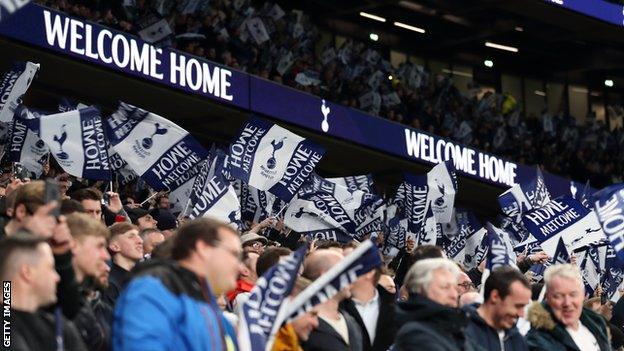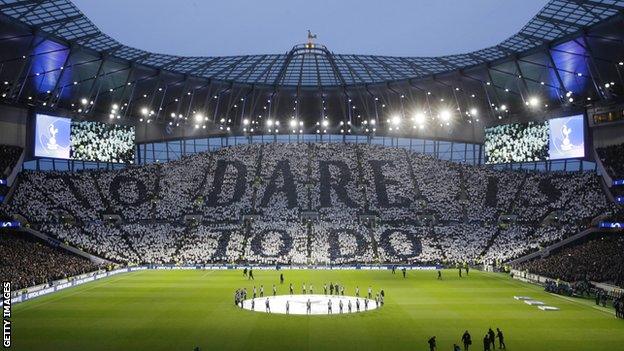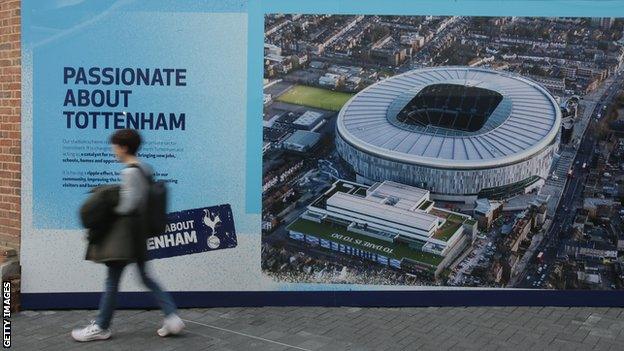Tottenham Hotspur: New stadium is like a town hall, architect says
- Published

The Tottenham Hotspur Stadium, as it will be called until the club concludes a naming rights deal
Tottenham's new £1bn state-of-the-art stadium is equivalent to the "town hall" of Tottenham, its architect says.
Christopher Lee designed the 62,062-seater stadium, which opened seven months behind schedule in early April.
The venue was designed to be at the heart of the community with facilities to rival the high street, he said.
And in sporting terms, Lee said he had tried to create "the most incredible, atmospheric, intimidating seating bowl you can play amazing football in".
Tottenham have settled in well to their new home, winning their first four games at the stadium, although West Ham became the first visiting team to win there on Saturday.
As well as being a sporting venue, the concourse boasts 65 food and drink outlets and its own microbrewery.
That's part of a plan to encourage Spurs fans to make a day of their trip, arriving earlier than they might normally do and staying longer.
"Football stadiums are stadiums, but the definition of a stadium is so much different to 10 or 20 years ago, they're very much civic buildings," the Australian architect told BBC Radio 5 Live's Nihal Arthanayake.
"This idea of private ownership, with emotional public ownership... I think the new Tottenham stadium is the equivalent of the town hall of Tottenham.
"Arsenal isn't the competition for Tottenham in a stadium design area, really the high street is the competition for the stadium.
"The challenge was, how can we design a new generation of stadium that competes with the kind of quality experience with food and drink as the high street?"
'Tricky' construction

Acoustics and atmosphere had to be taken into consideration during the construction process
As well as being held up by delays, the stadium also went considerably over its original £750m budget. The club played at Wembley Stadium while the new ground was being built.
Lee, who works for architects Populous, said Spurs chairman Daniel Levy pushed hard for the stadium to be ready for September 2018, but that ultimately wasn't possible.
"Building projects in central London are always tricky," Lee said. "The scale of the project was vast... In reality the club wanted to be in at the beginning of the season. Playing at Wembley is always tricky, where you're always away, even for your home games.
"So the ambition was to push, as Daniel does, as hard and as fast as he possibly can. Things didn't quite work out on the construction side as we had hoped."
Another challenge with creating the biggest club ground in London was to maintain character, charm and a sense of feeling "at home".
Lee said: "There's a real danger in designing these symmetrical bowls that [they] don't have any personality and character."
Those with a front-row seat are no more than eight metres from the touchline and the acoustics have been taken into account during construction to ensure there is a good atmosphere.
Creating a 'giant megaphone'

The South Stand is the largest single-tier stand in the country
The South Stand of the new stadium holds 17,500 seats, To put that into perspective, Bournemouth's Vitality Stadium has a total capacity of 11,329.
"The South Stand is very much part of that whole piece, it's a nod to the great English stadiums," Lee said.
"We've looked at the Yellow Wall of Borussia Dortmund. What we were really interested in was creating this giant megaphone that drives noise and songs and chanting.
"The great thing about football is this fantastic dialogue between home and away fans, between North Stand and South Stand, and when you start designing, thinking of it as a concert hall you really want quick reverberation, you want songs to not break down when people get out of time.
"If sound bounces around too much, one end gets out of time and the songs tend to stop.
"What we've designed for and what we've seen is this fantastic noise, really quick, one end talking to the other and building noise and it gets noisier and noisier and it's fantastic."
'A catalyst for regeneration'

Lee says the state-of-the-art stadium is rooted in the local community
The architect has worked on the project to redevelop the stadium and surrounding area for almost a decade, having previously worked on 30 international stadiums including Arsenal's Emirates Stadium.
"Feeling part of this huge community of people is what I love about football stadiums," he said.
"Football clubs are incredibly linked to their local communities. It's clearly privately owned but emotionally owned by the fans, and all clubs do incredible work through charitable works, most of which goes unseen.
"Tottenham have done a huge amount in Tottenham itself.
"Tottenham has been chronically underinvested in over the decades and rather than this building being this spaceship that lands that has nothing to do with the local community, it's very rooted in the local community and it's very much about creating a great space.
"The thing I'm most excited about is how it can act as a catalyst for a bigger regeneration."